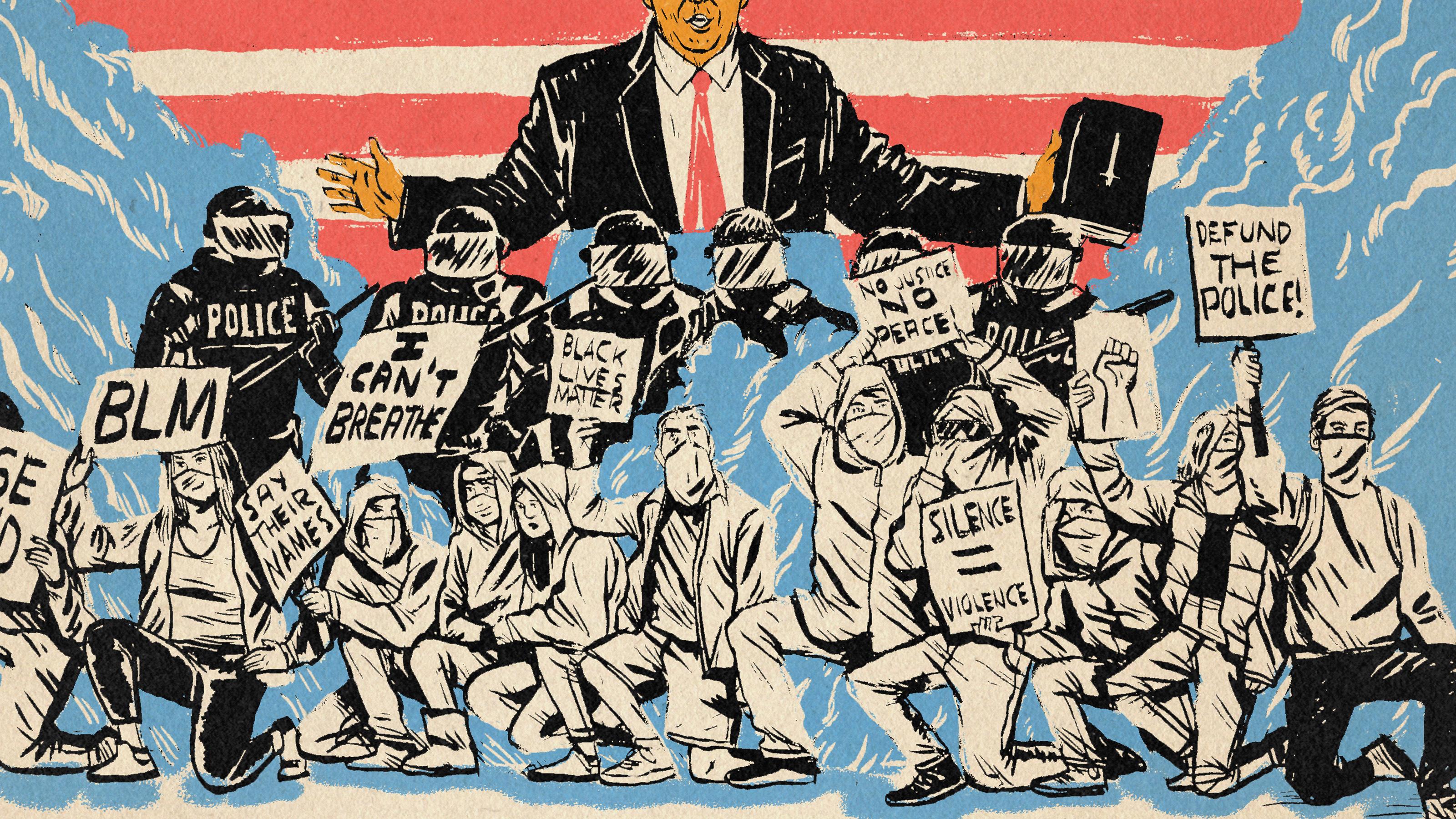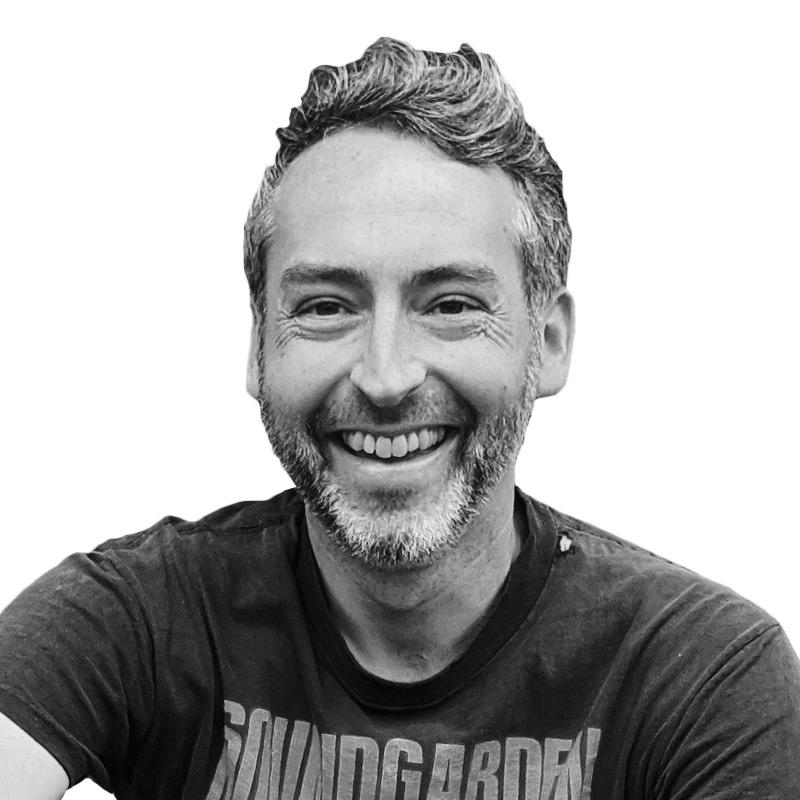One Night in D.C.: The Oral History of June 1, 2020
A day of peaceful protesting against the police killing of George Floyd turned violent in the nation’s capital, as President Trump forced people away from the area surrounding the White House. Here’s how a photo op became a flashpoint in the movement against racism.On May 25, 2020, Minneapolis police officer Derek Chauvin pressed his knee onto George Floyd’s neck for almost nine minutes, killing him while staring into the camera of a filming bystander, his three accompanying officers looking on. A week later, protests against yet another police killing of a Black person that began in Minnesota had spread across all 50 states.
Until June 1, the president of the United States had commented on the nationwide unrest only via his Twitter account. “These THUGS are dishonoring the memory of George Floyd… when the looting starts, the shooting starts,” Donald Trump tweeted, adopting a threat first used to intimidate protesters in the 1960s. As thousands gathered in Washington, D.C.’s Lafayette Square on May 29, Secret Service agents reportedly whisked Trump into a bunker. On May 31, the White House and its turned-off lights was an image almost too symbolic to be real. As criticism of his retreat in the face of a historical moment mounted a day later, Trump decided to show his face. That evening, in the White House Rose Garden, he vowed to “dominate the streets” and deemed himself “your president of law and order.”
“And now,” he said, “I am going … to a very, very special place.” Leaving the Rose Garden, Trump walked north from the White House, across an empty Lafayette Square, and eventually stopped in front of St. John’s, an Episcopal Church at 16th and H streets that sitting presidents have visited since its first service in 1816. In front of the house of worship, he posed while holding a Bible that his daughter had reportedly toted over in her $1,500 handbag. Minutes earlier, on the orders of U.S. Attorney General William Barr, U.S. Park Police, local police, Secret Service officers, and National Guard troops had used tear gas (the exact type is under dispute) and rubber bullets to drive protesters away from the exact spot where the president was standing. Trump’s ugly show of false piety, made in front of an audience of no one but press, his team, and his armed guards, put the violence that he had just orchestrated in greater relief.
Reporting live, MSNBC correspondent Garrett Haake knew he couldn’t soft-pedal what he was seeing. “As calmly as I could, I very specifically said what just happened,” Haake tells The Ringer. “I didn’t want it to be, ‘The president just spoke’ or ‘clash with protesters.’ There was no clash. People were forcibly, aggressively removed from that park with flash bangs and gas.”
The brazen display of force, captured on video in broad daylight during a demonstration calling attention to yet more instances of the extrajudicial killing of Black Americans—including Breonna Taylor, shot eight times in her home by still-uncharged Louisville police officers; and Ahmaud Arbery, stalked and shot in Southeast Georgia while jogging by three men now charged with murder—symbolized exactly what the current movement is protesting. The scourge of racist policing predates Trump by centuries, but rather than acknowledge it with consequential legislation, he and his allies seem set on crushing the nationwide uprising against it. That was nakedly apparent on the first day of June.
“It was a big mess,” says Trinice McNally, the founding director of the Center for Diversity, Inclusion & Multicultural Affairs at University of the District of Columbia and a member of the D.C. chapter of the Black Youth Project 100. “And it was a mess because of 45. Because he simply wanted a photo op. And to get his photo op he preferred to brutalize people who were protesting in the street.”
The photo op was one of many stunning moments on that Monday, a day that clarified the violence of the administration and calcified the movement against it. The early protests, the ferocious dispersal of the crowd, and the ensuing fallout added up to one of the most consequential 24-hour stretches in recent history—not just for D.C., but for the entire United States. Here is the story of how the events of Monday, June 1, in Washington became a flash point, as told by those who were on the ground.
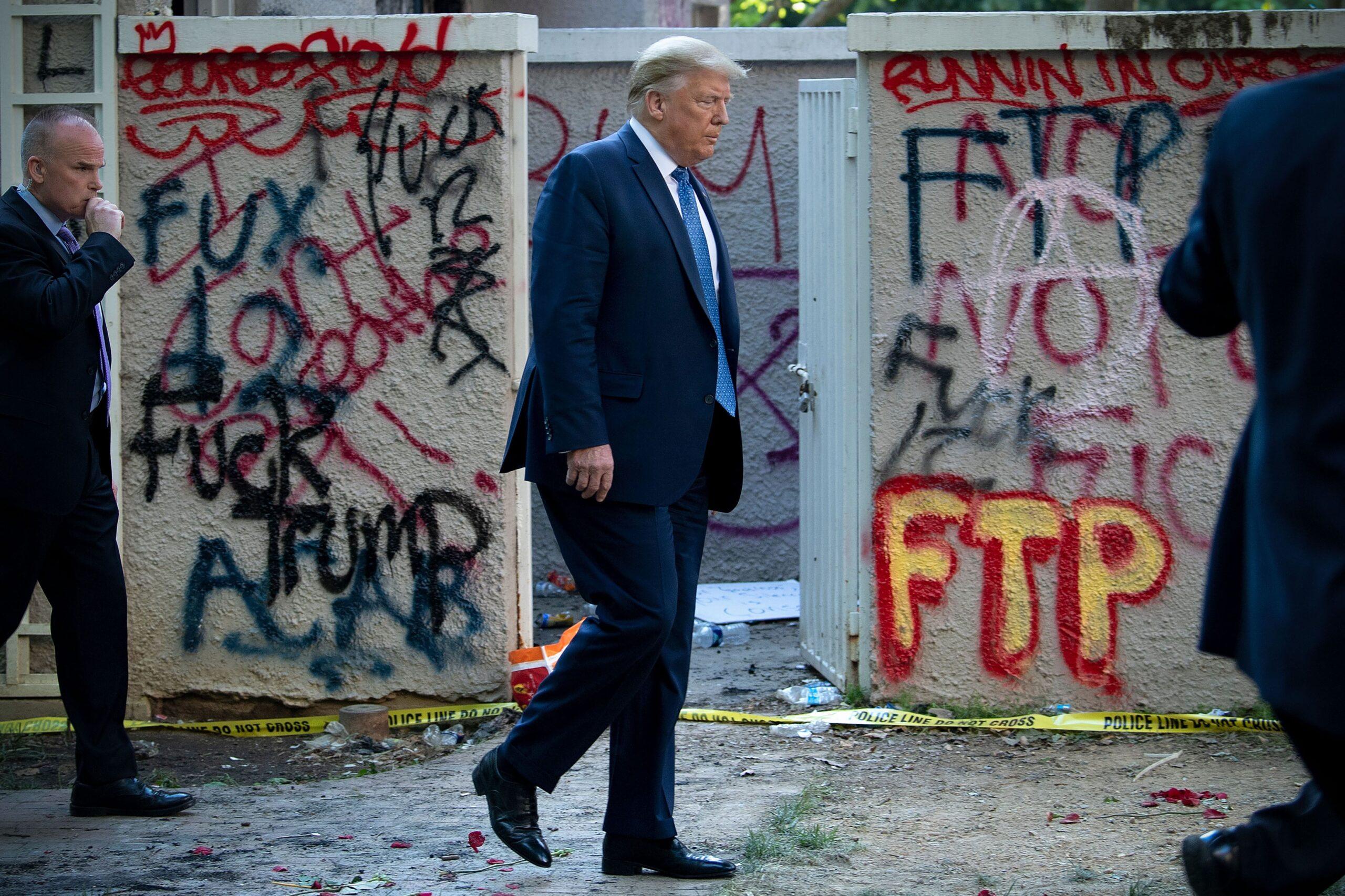
Part 1: “I See People Out There in the Streets Doing Something. I Want to Be a Part of That.”
By Friday, May 29, four days after the killing of Floyd and three days after protests began in Minneapolis, hundreds of people had assembled in Washington, D.C., a number that grew into the thousands as the weekend went on. The central location for the D.C. protests was (and still is) Lafayette Square, a park that abuts the northern border of the White House grounds, sitting between Pennsylvania Avenue and H Street, where St. John’s is located. Shaynna Ford, a 31-year-old fitness instructor from D.C., was protesting that weekend.
Shaynna Ford (protester): It kind of was an awakening for me. My dad’s Black, my uncles are Black. My brother’s Black. It didn’t feel right to sit at home and do nothing when I could at least show up and allow my voice to be heard as a Black person in America. This is actually my first time ever in the streets for anything. Which is pretty surprising being that I’m 31 years old and a pretty outspoken person. With coronavirus, everybody—well, not everybody, but a lot of people—have been at home for months on end and you’re forced to consume what’s going on around you. It’s easy when you’re busy with work to get distracted and voluntarily shield yourself from the things that are really going on. But I kind of just felt helpless sitting at home every day doing nothing. I remember texting my friend [on May 28], thinking, “Guys, is there gonna be a protest? How is there not a protest? This is D.C.; we should be doing something.” And then I woke up the next morning and someone had DM’ed me the flyer for the protest.
Brian Gabriel Jr. (protester and National Democratic Redistricting Committee states press secretary): I had been sitting there, getting some rest, just hanging out, not paying too much attention to my phone, looking at the TV, looking at the protest. I just felt an immense amount of guilt. I haven’t said this explicitly: I’m Black. I feel like that’s important. I was looking at it like, “Well, I’m out here working for [former U.S. Attorney General] Eric Holder, I’m trying to do my part behind the scenes,” so I feel attached to it in that way. But I see people out there in the streets doing something. I want to be a part of that.
Garrett Haake (MSNBC correspondent): On Saturday and Sunday, the emotions were just so raw. People were so angry and so upset and the atmosphere was so charged.
Douglas Reyes-Ceron (protester): In general, it’s peaceful but tense and angry. People aren’t dumb. People are smart about this. But the common denominator is: Everyone’s pissed.
In many cities across the country, police met the protests against police brutality with more brutality. On May 26, police officers used tear gas on protesters in Minneapolis; four days later, videos from Brooklyn showed an NYPD officer pushing a woman to the ground, and another driving through a crowd of protesters. On May 30 in D.C., police began using tear gas, pepper spray, flash bang grenades, and fire hoses to clear protesters near the White House. After D.C. Mayor Muriel Bowser instituted an 11 p.m. curfew for Sunday, May 31, a fire was set in the basement of the St. John’s parish house. The police’s violent tactics only increased the size and intensity of the movement, in the city and nationwide.
Nassim Touil (protester): I’m an EMT, I actually go to [George Washington University]. The first few days I was there I wasn’t doing any sort of medical care or anything like that. Around Sunday is when I started carrying my own basic first-aid stuff.
Ford (protester): [From Friday] until that Monday when everything that happened with the president, Nassim and I had essentially been going to war every single day with the police [near the White House].
People aren’t dumb. People are smart about this. But the common denominator is: Everyone’s pissed.Douglas Reyes-Ceron
Touil (protester): Sunday was really, really aggressive by [the Metropolitan Police Department].
Haake (MSNBC correspondent): We knew the cops were gonna clear the street at 11, so there was a crescendo from about 10:15 to 11.
Ford (protester): It was super, super, super tense. Nobody was going out there without personal protective equipment, in terms of goggles, gas masks if they had them, multiple layers of clothing. The atmosphere was that of, “If you come out here, be ready to engage.” The police will engage you physically whether you initiate or not.
D.C. police Chief Peter Newsham said that the Metropolitan Police Department made 88 arrests on May 31. The following morning of June 1, Mayor Bowser announced that the city would institute a 7 p.m. curfew for the next two evenings. Early that day, protesters again began gathering at Lafayette Square. Though the White House would eventually erect 8-feet-high fences blocking entry into the park, on June 1 protesters found a perimeter of waist-high barriers and Park Police.
Ford (protester): The mood was calm enough to where people thought, “It’s OK to be out here because there’s a curfew tonight, and as long as we leave before the curfew, everything will be fine.”
Gabriel (protester and National Democratic Redistricting Committee press secretary): Once again, I’m not a serial protester or anything. I can look at a situation and realize, “Nobody here is antagonizing anyone else.” Everybody’s doing protest chants, signs everywhere.
Justin Finch (NBC4 Washington reporter): It didn’t really start to build that morning. I guess people were sleeping it off from Sunday. It was hard to imagine that Monday would happen the way it did.
Ford (protester): People had their kids out there; they had their pets out there; it was definitely a different vibe than the two days before, 100 percent.
Touil (protester): The mood, at that time, wasn’t really aggressive. Usually I can say that it starts to get a little bit more agitated. It was very community based. People were walking around like they always do, handing out waters. People were sitting on this guard house talking; people were dancing.
Gabriel (protester and National Democratic Redistricting Committee press secretary): Me and my cousin, we like to be in the mix, so we went right up to the gate on H Street. We want to see what’s going on. And I’m looking at Lafayette Square. Everybody’s being cool.
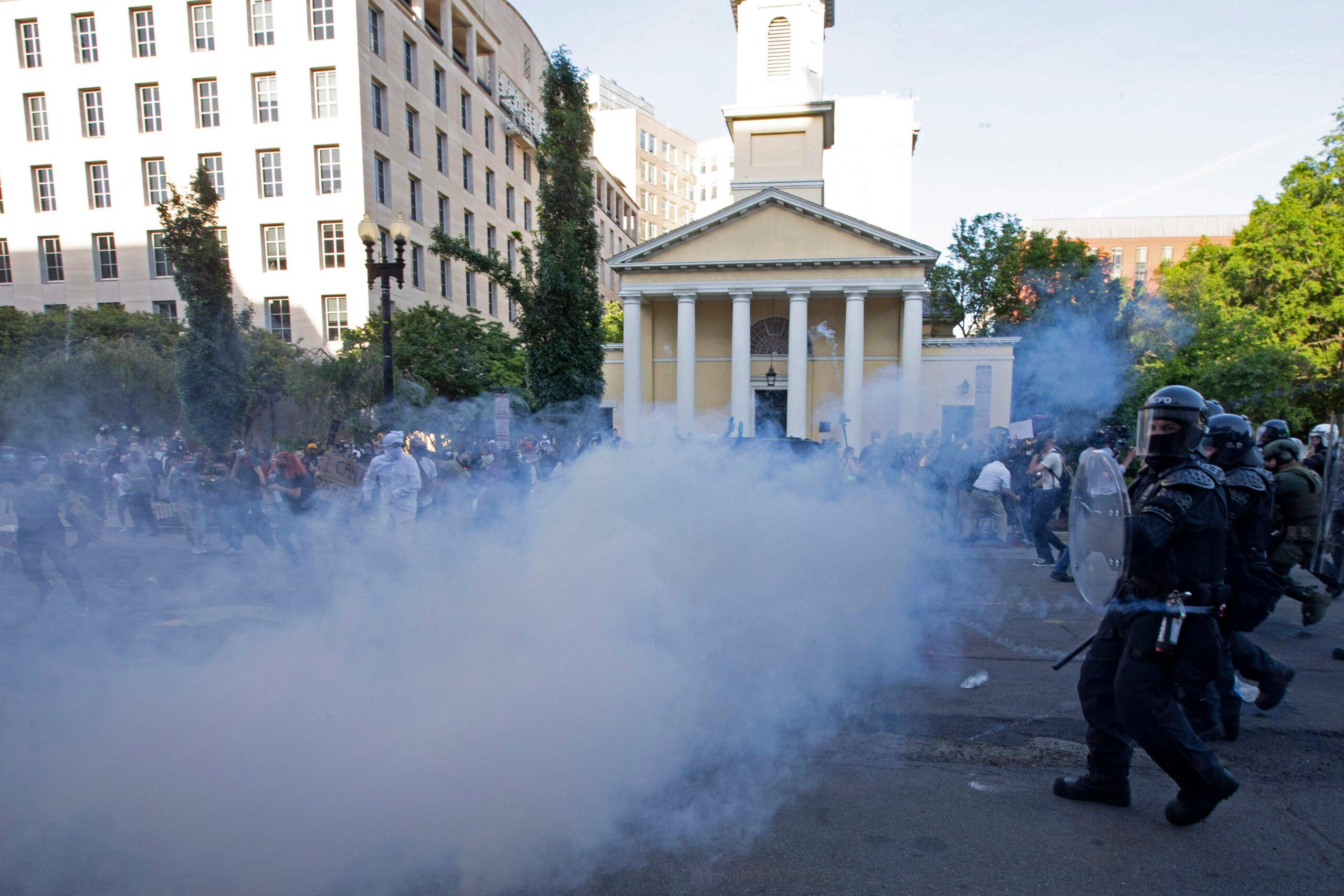
Part 2: “From Protest to Pandemonium”
Earlier on June 1, an increasingly petulant Trump had lashed out. On a conference call, the president told America’s governors that their “weak” response to protests made them “look like fools,” while Defense Secretary Mark Esper urged the group to “dominate the battlespace.”
Meanwhile, The New York Times reported, some of Trump’s closest advisers planned for him to make a speech in the Rose Garden and then walk to St. John’s. The administration hastily threw together a plan that authorized security forces, including the D.C. National Guard, to clear out the protesters, who by early evening had again gathered outside the White House. They had no idea what was coming.
Reyes-Ceron (protester): I’ve lived here for so long. I’ve seen a bunch of initiatives regarding things like immigration, the environment, women’s rights. All sorts of things. I had never seen a police or military presence that large for a protest before. I’ve seen military Humvees at events before, but never to that scale and that much of a perimeter. Every street I would go up was a different layer of police and military. I was like, “What the fuck is this?”
Trinice McNally (founding director of the Center for Diversity, Inclusion & Multicultural Affairs at University of the District of Columbia and member of the D.C. chapter of the Black Youth Project 100): People don’t even know: We have over 30 forces of police here.
Haake (MSNBC correspondent): We just saw this continual build-up on the other side of the fence from the heavily armored law enforcement. It was Park Police, National Guard, Secret Service, more and more and more throughout the course of the day.
Gabriel (protester and National Democratic Redistricting Committee press secretary): They’re shoulder-to-shoulder with their shields and whatnot, and they’re not at the bike rack—they’re about 20, 30 feet away. And they’re just posted up.
Haake (MSNBC correspondent): A little after 6 we saw Barr come out and take this walk around with a couple of guys in suits. The crowd was booing lustily. It was a very unwelcome sight.
Gabriel (protester and National Democratic Redistricting Committee press secretary): You can see people in the background with suits on, obviously staff.
Haake (MSNBC correspondent): In my email I saw, “Well, we’re expecting the president to speak in the Rose Garden.” If I remember correctly, first he was supposed to speak at 6 and then it was pushed back to 6:15, and then it was pushed back to 6:30. The whole time it was like, “Well, this is gonna be interesting.” It’s still pretty loud out there.
Reyes-Ceron (protester): I was getting really nervous. Because they were clearly trying to physically show force just by being there. In my head I was like, “I’ve got a bad feeling about this, man.” This is not good.
It lands on your skin. It stays on you. It burns. You can’t see. You can’t breathe. Some people, they choke.Nassim Touil
Gabriel (protester and National Democratic Redistricting Committee press secretary): I’m a veteran. I was in the Marine Corps from 2007 to 2011, did a year in Afghanistan. I was a public affairs Marine, with a camera. I literally have been a combat photographer before. So I can look at the National Guardsmen and I can identify them just going off their rank and their unit patches and stuff like that. They were fresh-faced and they obviously had not been trained for this sort of thing. I was like, “Dang, I can’t believe they picked this group of people to do this.” And I feel for ’em, too, because as a veteran, nobody signs up for the military thinking you are gonna have to engage American citizens.
On June 10, The New York Times reported that “some of the Guard troops were just out of basic training, and others had no experience in controlling disturbances in the streets.”
Touil (protester): I have a photo. At 6:18 [law enforcement] started mobilizing. They started moving out.
Haake (MSNBC correspondent): The lines of Park Police, and Secret Service, and National Guard started moving toward the fence. Like, getting closer and closer to the fence.
In a statement, White House spokesperson Judd Deere told Vox that the Park Police issued three dispersal warnings to protesters to “help enforce the 7:00 pm curfew.” Witnesses told The Washington Post that the orders were difficult to hear.
Ford (protester): It didn’t make any sense, how aggressive they were at clearing out that area, especially 30 minutes before [curfew]. It just didn’t make any sense. The amount of police officers, the military police, they had the Park Police, horse-mounted police. It just didn’t make any sense. It was very confusing.
Ken Duffy (WTOP anchor): All of a sudden the Park Police on horseback started moving forward, and the flash bangs came, and all hell broke loose.
Gabriel (protester and National Democratic Redistricting Committee press secretary): Nobody on our side is putting their hands on anybody, on the cops or the National Guard. They eventually get closer and then at, like, 6:45-ish, they start a hard push.
Touil (protester): There were the pepper spray balls, there were rubber bullets, and there were flash bangs. It really went from 0 to 100 out of nowhere. It wasn’t like people were antagonizing.
Haake (correspondent): At one point, we’re backing up and we’re right face-to-face with the mounted police, and in my right ear, I’m hearing Trump speak. I’m hearing the president say, “I’m a friend of all peaceful protesters.” And, “I’m your law-and-order president.” And in my other ear I’m hearing my producer scream, “Get back! Back up! Back up!” And I’ve got my hand on my photographer’s shoulder so that he can walk backward and shoot video while I’m trying to narrate it and I’m hearing all this in my ear at the same time. It was an absolutely surreal moment. And it happened almost out of nowhere. There was no amping up of tensions, there was none of that feeling of, “This is gonna go down.” Within 15 minutes, it went from protest to pandemonium.
Duffy (WTOP anchor): I heard something happening, in the area of 16th and H right at the intersection. I was maybe a few yards away. I heard a little commotion. And as I walked over there, I asked somebody to my right, “What happened?” And according to him—this was before they really cleared everybody out—someone was tear-gassed.
Ford (protester): I could feel it. I had to stop and pour water on my face. Everybody around me was coughing. It’s almost like an assault on your respiratory system. Any orifice that you have that things could get into, it’s like an assault on that. It just incapacitates you.
Touil (protester): It lands on your skin. It stays on you. It burns. You can’t see. You can’t breathe. Some people, they choke. They start throwing up. They gag themselves to throw up. You’re seeing people vomiting. You’re seeing people go down.
Haake (correspondent): We were turning south on 17th Street, trying to get out of the way. And that’s when I felt the gas. I have an NBC-issued gas mask, I’ve been trained how to use it, and at that corner—and here’s a 2020 thing for you—I had to rip off my coronavirus face mask, literally rip that thing off my face, so I could get the gas mask over my head, and snugly fit it around my face, and took two or three deep breaths to like clear the mask of the gas so that I could actually breathe again.
Duffy (WTOP anchor): I did basic training in ROTC. There was a moment where they put us into a room and exposed us to tear gas, and I’m telling you, that memory, in my head, I remembered that smell. I’ll just say that.
Gabriel (protester and National Democratic Redistricting Committee press secretary): I’ve done gas mask training in the military a number of times before. I recall that feeling. And it’s not just that the smoke gets in your face—it’s an irritant that you can feel on your skin. Obviously they were using tear gas or a variation thereof.
In the following days, the Trump administration and law enforcement agencies denied that they had used tear gas. In a June 2 statement, U.S. Park Police acting Chief Gregory T. Monahan said that “no tear gas was used by USPP or other assisting law enforcement partners to close the area of Lafayette Park.” On June 3, White House press secretary Kayleigh McEnany said “no one was tear-gassed.” Monahan doubled down two days later, erroneously calling the protesters “violent” and saying that “United States Park Police officers and other assisting law enforcement partners did not use tear gas or OC Skat Shells to close the area at Lafayette Park.” Video from the scene showed otherwise, and tear gas canisters were later found in the park.
On June 7, Barr smeared those who had gathered near the White House on June 1. “They were not peaceful protesters,” he claimed.
Duffy (WTOP anchor): It was peaceful.
Gabriel (protester): You messed up a peaceful protest.
Touil (protester): There was a total disregard for everyone because they just wanted to move hard and fast. And it was because they needed to quote-unquote secure the site for the president during a very volatile time.
Ford (protester): It was unbelievable watching everybody running. It felt like you were in a war zone. And then [because of] a combination of all the days and everything that had been happening, I just had a mental breakdown. I just started sobbing in front of them when I was holding my sign. It was overwhelming.
Gabriel (protester): People were very scared. I could see the fear in their eyes. I could hear the screaming that folks were doing.
Haake (correspondent): At one point, I think you see this on TV, there are two guys carrying a woman who had tripped and fallen during the stampede, and they’re running past us and my instinct is to stick a mic at them and ask, “Hey, are you OK?” And the guy yelled at me on live TV, “She’s not fucking OK.”
Gabriel (protester): The thing that was most upsetting was that it was completely uncalled for. Nobody provoked the police. As we now know, there was a reason we were getting cleared out. I had no idea and I didn’t find out what it was about until I got home. And I saw the photo op and I was like, “Oh, that totally makes sense why they did that.” Because he had to take a walk across the street.
The Right Reverend Mariann Budde (Episcopal bishop of Washington, to Today): Consider the context. After making a highly charged, emotional speech to the nation where he threatened military force, his officials cleared peaceful protests with tear gas and horses and walked on to the courtyard of St. John’s Church and held up a Bible as if it were a prop or an extension of his military and authoritarian position, and stood in front of our building as if it were a backdrop for his agenda.
The Most Reverend Michael Curry (Episcopal Church presiding bishop): He used a church building and the Holy Bible for partisan political purposes. This was done in a time of deep hurt and pain in our country, and his action did nothing to help us or to heal us.
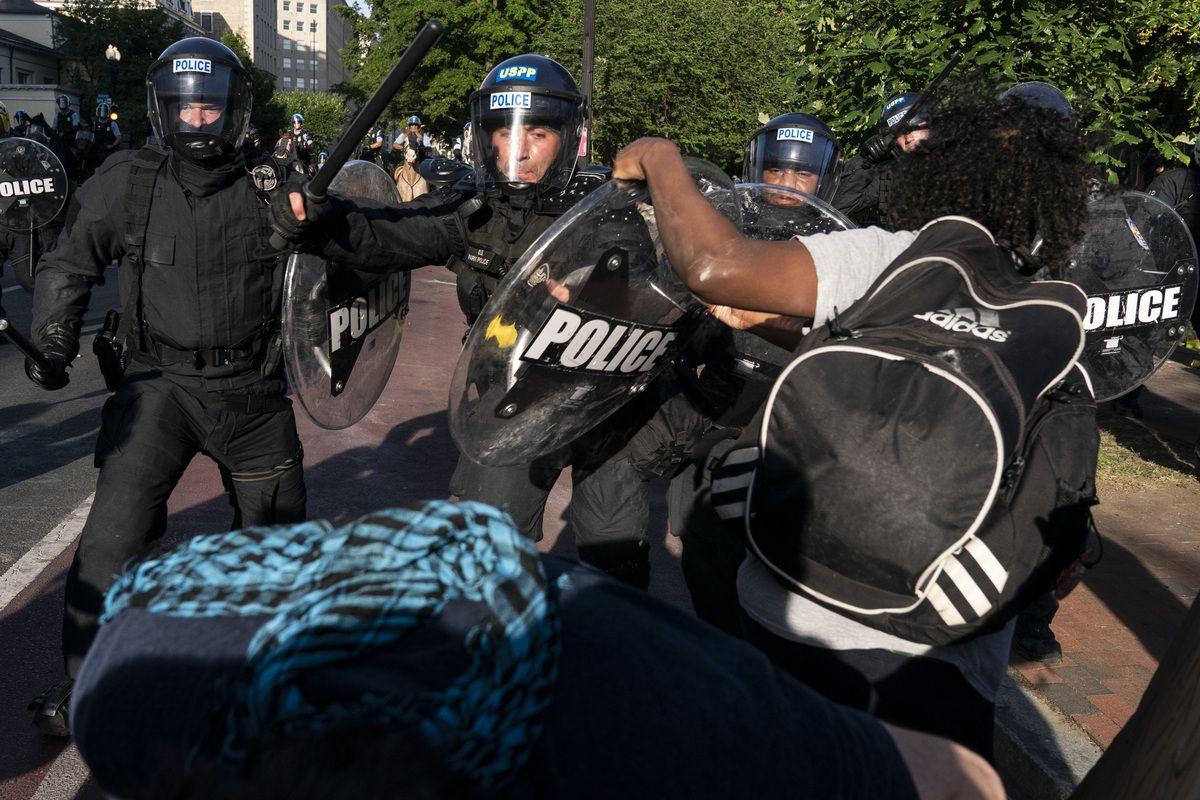
Part 3: “It Was Something People Needed to See.”
After the sweep of Lafayette Square on the night of June 1, law enforcement forced groups of protesters to splinter off from the White House. Some headed toward Chinatown, about a mile east of the White House. There, the crackdown on protesters continued, this time in the form of low-flying military helicopters.
Anna (protester): Around curfew time, we had seen the helicopters overhead. Like, flying over K Street, L Street, M Street. … Folks in fatigues, you could see their feet hanging out of the sides of the helicopters. There were three or four on each side. You could see the rifles. We were aware of them flying around. But we had no idea what was coming.
Gabriel (protester): It’s super frustrating because, I mean, we’ve already seen the tension between citizens and the police. Why bring the military into that and exacerbate the situation and make it political for them? It’s also frustrating seeing military equipment being used against Americans. I don’t think I really have to go into why that’s inappropriate.
Anna (protester): I was in this march with folks for a little while, a few miles, and we were in the Chinatown area when the first chopper descended on us. That was the Black Hawk.
Gabriel (protester): I’m very familiar with how strong those rotors are. Blowing shit everywhere. You’ve gotta cover your face.
Anna (protester): I sort of got knocked down. People started to scatter a little bit. It was terrifying.
Gabriel (protester): I had been trained for that and I’m familiar with that. But if you do this to a group of civilians who are not expecting it, and you’re doing it to harass them …
Anna (protester): We eventually sort of regrouped and started moving again. And I think the Lakota with the cross on the side descended on us.
Anna, who prefers that her last name not be used, managed to shoot a video of the debris-spraying Lakota, a medical helicopter, flying dangerously low above Chinatown.
Anna (protester): I had to hold up my phone toward it and look in the other direction. There was stuff flying in my face. I felt like it was something people needed to see. I’d never seen that before.
[Editor’s note: The helicopter shown in the video above is a Lakota.]
On June 6, Army Secretary Ryan D. McCarthy told The New York Times that the helicopter use was being investigated. According to the report, pilots of one of the helicopters had been grounded during the inquiry.
Anna (protester): My adrenaline lasted about two days. And it started to come down around Wednesday or so, and that’s when I realized what I’d been through and that my body hurt.
After law enforcement pushed crowds away from the area around the White House on the night of June 1, one march ended up on Swann Street Northwest between 14th and 15th, a tiny neighborhood about a mile north of the White House.
Duffy (anchor): This group that I was with was way ahead, so I had to run up to catch up to them. They were stopped at one point at Florida Avenue, and then they hooked a left onto Florida Avenue Northwest, and it looked like they were headed toward Adams Morgan. It seemed like they were on the way there, but then there were cops positioned at different intersections. They had one police cruiser at one intersection just deploying flash bangs. And just directing this crowd down 15th. It was a peaceful march. We couldn’t go further west. So we all went down 15th.
Rahul Dubey (Swann Street resident): I walked inside and I got a bottle of water and I stood on the stoop. The top step. This is 8:45. No one is on Swann right now. I’m wondering what’s going on. There’s a military helicopter above the houses. I’m like, “What the hell?” I see stragglers coming through. And they’re in twos and in threes and some are carrying signs.
Duffy (anchor): They turned down Swann Street and I started to follow them. And then all of a sudden, literally yards walking into that block, there were more flash bangs and then the cops filled in behind us.
Meka (protester): We were marching down Swann Street; that’s when we realized that the cops cut us off at the end of the road. We turned around and then we realized the cops had come in behind us and boxed us in.
The thing that was most upsetting was that it was completely uncalled for. Nobody provoked the police.Brian Gabriel Jr.
Duffy (anchor): They had blocked off this block, completely. And then I looked to my left, I see that there are protesters with their hands up just standing there, and then I looked a little farther down the corner and there were police down the alley. And then I looked down my right and there were more police down another alley. They covered all the alleys along that block so no one could go anywhere.
Meka (protester): We were there for 30 minutes just standing around, trying to figure out what to do, asking the cops what they wanted us to do, because we were stuck there and wouldn’t let us leave.
Duffy (anchor): The media was technically exempt from the curfew. We were allowed to be out there covering it. People are like, “Why didn’t you just present your badge?” But when you’re facing 40 cops in riot gear on a street, I’m not gonna go walking up to them with my hand up and saying I’m from the media. It’s not a couple cops.
Dubey (Swann Street resident): Swann Street was filled up about three-quarters. They’re chanting “Let us go, let us go, let us go,” or “Black Lives Matter,” or “Don’t shoot.” It was peaceful.
Duffy (anchor): I approached this one residence, this one basement apartment. I saw a girl watching from the window, so I waved to her and I presented my badge, and I was saying, “Could you come out?” I think I was one of the first people to do it, actually, because she had nobody in the house yet. She came out and I identified myself. I said, “Look, is it OK if I hang out here and maybe come inside with you maybe until this blows over?” She agreed. But then there were protesters who had the same idea. They didn’t want to get arrested. Some of them followed me into this girl’s place. So we were out on the patio. Then all of a sudden commotion started.
Dubey (Swann Street resident): It’s 9:15 and I walk out to the stoop. My door opens out.
Meka (protester): The [police] just started closing in on us, macing people, hitting people, and it got pretty chaotic, pretty fast. I was with a friend, and when this all went down, I looked for him immediately, and I saw him running up the stairs and calling my name.
Garrett Reaves (protester): We were on the other side of the street and I saw my friend say, “Come on, hurry up,” ’cause I saw someone like 5 feet ahead of me get hit with a club in the head [by police] multiple times.
Meka (protester): I saw Rahul holding the door open.
Reaves (protester): He let us in.
Dubey (Swann Street resident): I wedged myself between the door and the railing. I had my arms spread, my right foot is on the top step, my left leg is on the third step from that, and I am just straddling. And all I keep thinking is, “Keep this door open. Get them in the house.” And the police are moving closer.
Meka (protester): The cops chased us to the house and pepper-sprayed us.
Reaves (protester): For the first 10 minutes of being in Rahul’s house, it was mayhem. People were coughing, people had to pour milk on each other.
Meka (protester): We didn’t know if the police were gonna be able to come in the house. We thought they might bum-rush the place. We weren’t sure. Once we realized they weren’t allowed to and we had the cameras on us, people started to relax.
Dubey (Swann Street resident): Seventy-plus were safe. Some of them were taking a nap. Some of them were just talking. There was no more panic in people’s eyes.
Meka (protester): We figured out how to get food there.
Dubey ordered from Duccini’s Pizza, which delivered the pies over his home’s back fence. The protesters stayed there until 6 a.m., when the curfew expired. They left without being detained. On the night of June 1, MPD made more than 300 arrests, mostly for curfew violations.
Finch (NBC4 Washington reporter): We spoke with two women who were in the house, who were kind of saying, “We’re all strangers in the house. This is The Real World. Ha ha ha.” I thought what was strange was we had to kind of convince them that the police were not outside. There was still such shell shock that they were followed and cornered, they were telling us. Police were trying to reach for them and pull them back outside.
Duffy (anchor): It was a very dangerous situation.
Finch (reporter): I think the shock of seeing the munitions use in Lafayette Square, the aggression with which they were trying to get away from that scene, a few of them may have seen their lives flash before their eyes.
Duffy (anchor): I do believe that these homeowners saved lives by taking people in.
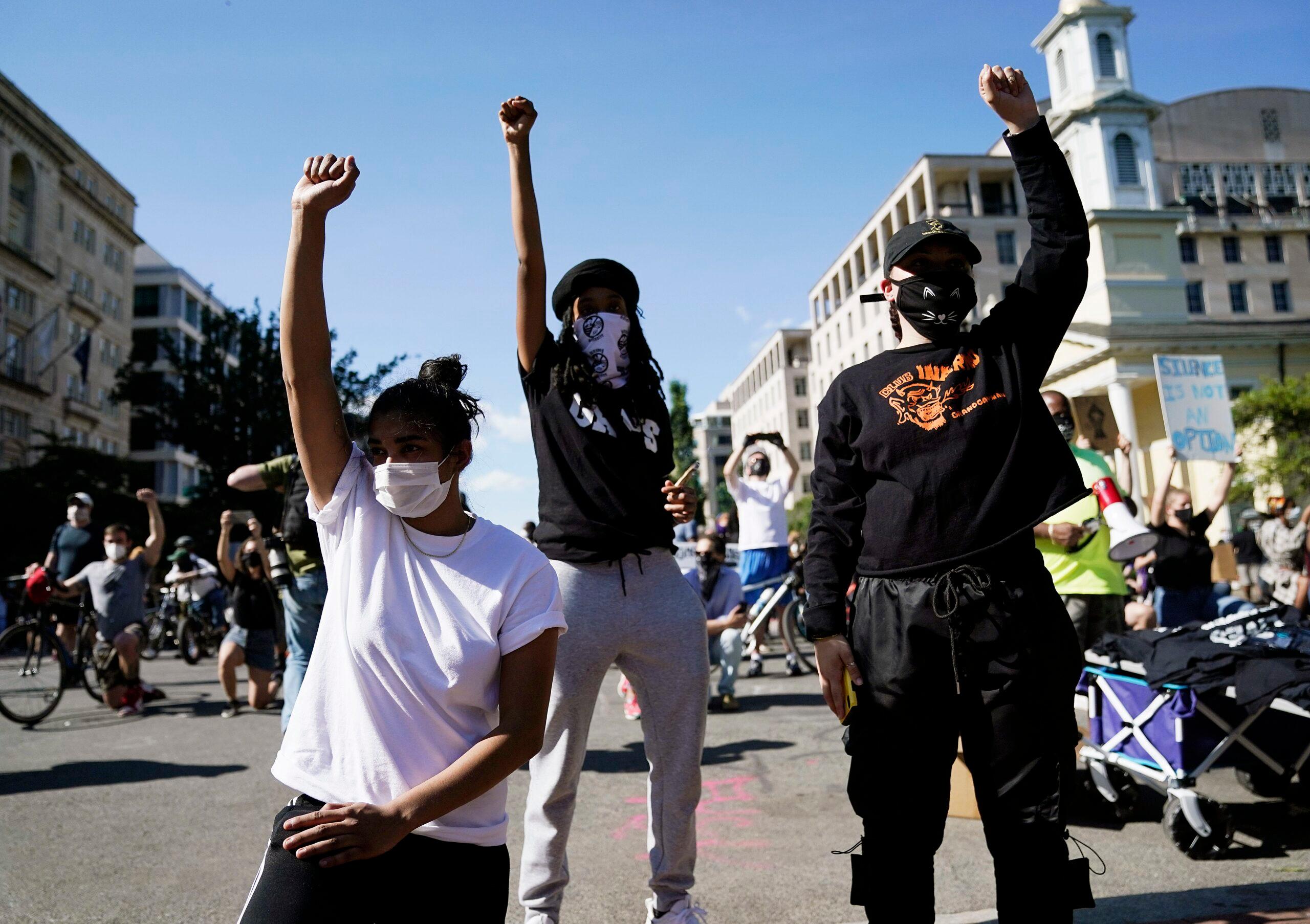
Part 4: “I’m Going Back Out There.”
The Trump administration’s violent response to the protests the evening of June 1 is now the subject of several lawsuits. The D.C. chapter of Black Lives Matter and the American Civil Liberties Union are suing Trump for civil rights violations. A group of plaintiffs represented by Gibson, Dunn & Crutcher also filed suit. “The Trump administration’s vicious attack on peaceful protesters in Lafayette Park was an unprecedented abuse of power that violated our clients’ fundamental constitutional rights to advocate for racial justice,” the firm said in a statement. “The use of a paramilitary force to target peaceful civilians, spraying them with tear gas, flash-bang grenades, smoke bombs and rubber bullets, simply shocks the conscience. Such an atrocity can never happen again.”
The administration’s response to the protests also drew the ire of Black members of the D.C. National Guard who objected to being turned against their fellow citizens who, in some cases, were their friends and relatives. The brutality even led Esper to distance himself from the administration’s use of force.
Even beyond the way June 1 laid bare the administration’s failures and further galvanized the Black Lives Matter movement, the president’s disregard for D.C.’s autonomy—at one point he threatened to take over Washington’s police force in order to snuff out the protests—has also led to a renewed interest from local and national politicians like Mayor Bowser, D.C. congressional Delegate Eleanor Holmes Norton, and U.S. Representative Steny Hoyer in D.C.’s fight for full representation. Even if it’s likely to go nowhere in the Senate, the House passed a bill for D.C. statehood on June 26.
By the end of the week of June 1, the protests against racist police brutality in D.C. had grown exponentially. While Trump’s capacity for cruelty and incompetence has been on display since the day he took office, the first day of June was a crystal-clear distillation of his administration’s disregard for its citizens. It was a flash point, and yet another reminder of how far America has to go in the pursuit of racial justice.
Gabriel (protester and National Democratic Redistricting Committee press secretary): What June 1 did was: It made it real for a lot of people, for a lot of Americans.
Duffy (WTOP anchor): It was a pivotal moment in this movement.
Haake (MSNBC correspondent): It sort of reignited a sense of why people were out there, and a sense that the government wasn’t listening to them.
Gabriel (protester): It’s been real for a while now. And folks are not surprised this is happening. But what this did was show a lot of Americans that this isn’t just something that happens with police departments in rural towns that are minority African American.
“What June 1 did was: It made it real for a lot of people, for a lot of Americans.“—Brian Gabriel Jr.
Finch (reporter): When you don’t live in D.C. and you watch the inauguration, you see the presidents go to that church across the street, you don’t really get how it fits into the fabric of the city. And for a lot of people here, something about [Trump’s photo op] irked them, or riled them in a way that may have galvanized a lot of people to show up.
McNally (Center for Diversity, Inclusion & Multicultural Affairs): I just felt so disgusted and so immediately alarmed that, “Yo, this is urgent. Right? And the whole country is watching.” Really, the blood is on his hands. Not just his hands but everyone that enables him as well.
Ford (protester): I really don’t want people to lose sight of why we’re down there. We got this quote-unquote [Black Lives Matter] Plaza. We got this quote-unquote [Black Lives Matter] mural. People are selling things and there’s music and I was just like, “This is all great, guys, but don’t forget that there’s work to be done and we’re down here for a reason.”
Gabriel (protester): If you’re gonna be shooting tear gas at me, I can’t stand for that. I’m not gonna just go home, lick my wounds, and be sad about it. I’m going back out there.
Ford (protester): I went back out the next day. I’ve been out there for 14 days straight. All day. I don’t plan on just throwing in the towel.
Gabriel (protester): This is not a joke. These are not just some protests that are gonna go away in a couple days. The president used the government and police forces to harm American citizens. If this doesn’t get your attention, I’m not sure what else will. This isn’t just a couple of bad apples. There are people in the highest levels of government who are not only endorsing this sort of behavior, but literally ordering it. What else needs to happen for you to understand that Black people are in danger?
